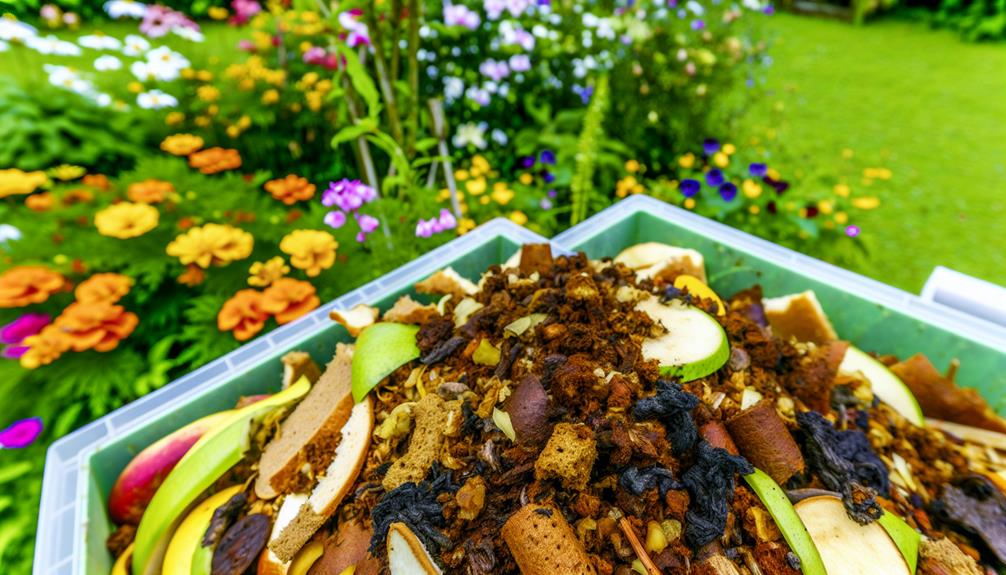

Yes, you can compost bread! It’s rich in organic matter, making it great for enriching your compost. Tear it into small pieces to speed up decomposition, and mix it with other materials to balance carbon and nitrogen. Stale or moldy bread works best, but avoid high-fat types to prevent attracting pests.
Properly manage moisture and aerate your compost regularly to avoid mold and odors. Composting bread reduces food waste, enhances nutrient cycling, and supports environmental sustainability. With the right techniques, your compost will thrive, turning bread into valuable garden nutrients. And there’s more to discover about maximizing your composting efforts!
Understanding the basics of composting bread can help you maximize the potential of your kitchen waste. When you compost bread, you’re transforming something that might otherwise go to waste into valuable nutrients for your garden.
Bread is rich in organic matter, which breaks down to enrich your compost pile. Start by tearing the bread into smaller pieces, which helps it decompose faster. Mix it well with other compost materials like fruit peels, vegetable scraps, and leaves to balance the carbon and nitrogen ratio. You’ll want to avoid large chunks, as they can attract pests.
Regularly turning your compost promotes good aeration, speeding up the decomposition process. By composting bread, you’re contributing to a sustainable cycle, fostering a sense of community and shared responsibility.
When deciding which types of bread to compost, you should know that both white and whole grain varieties break down effectively in your compost pile.
Stale or moldy bread is perfect for composting, as its organic nature accelerates decomposition. Avoid bread with high-fat content or those containing oils, as they can attract pests and slow down the process.
Rye bread, sourdough, and even cornbread can join your compost heap, enriching it with their diverse nutrients. Just tear or cut the bread into smaller pieces to speed up its breakdown.
Also Read: Can You Compost Baking Soda?
Composting bread provides numerous benefits, including enriching your compost with essential nutrients and reducing food waste. When you compost bread, you’re recycling and keeping it out of landfills, which helps the environment. Bread breaks down quickly and adds valuable carbon to your compost, balancing the nitrogen from green materials.

Here’s a quick overview:
| Benefit | Explanation |
|---|---|
| Nutrient Boost | Bread provides essential nutrients to your compost pile. |
| Quick Breakdown | Bread decomposes rapidly, speeding up composting. |
| Waste Reduction | Reduces the amount of food waste in landfills. |
| Carbon Addition | Adds carbon, balancing nitrogen-rich compost materials. |
Despite the benefits, have you considered the potential issues that might arise when adding bread to your compost?
Bread can attract unwanted moisture, leading to mold and unpleasant odors. This excessive moisture can disrupt the balance of your compost pile, making it less effective.
Additionally, bread decomposes quickly, which might create an imbalance in the carbon-to-nitrogen ratio, important for healthy compost. When bread breaks down too fast, it can cause your compost to become too wet and compacted, preventing proper aeration.
This lack of airflow can slow down the composting process, resulting in a slimy and smelly pile. By being aware of these potential issues, you can take steps to manage them and maintain a healthy compost system.
You should also consider how adding bread to your compost can attract pests like rodents and insects. These critters are drawn to the sugars and starches in bread, potentially turning your compost bin into an unwanted buffet.
To prevent this, always bury bread scraps deep within the compost pile, mixing them well with other organic materials like leaves and grass clippings. You can also use a compost bin with a secure lid to keep pests at bay.
Also Read: Can You Compost Asparagus?
To maintain unpleasant odors from surfacing, make sure bread scraps are well-mixed with other compost materials and not left exposed. You want a balanced mix of greens and browns, so cover bread pieces with materials like leaves, straw, or used coffee grounds. This helps absorb moisture and reduces the chance of bad smells.
Always guarantee your compost pile has proper aeration, turning it regularly to help with decomposition and minimize odors. By being diligent about these steps, you’ll not only prevent unpleasant smells but also create a healthier, faster-composting environment.
Before adding bread to your compost, it’s important to prepare it properly to guarantee efficient decomposition and avoid attracting pests.
Start by breaking the bread into small pieces; this increases the surface area, helping it break down quicker. Stale bread works best since it’s already on its way to decomposing. Avoid adding bread with mold, as certain molds can be harmful.
Mixing the bread with other compost materials, like leaves and vegetable scraps, balances the carbon-to-nitrogen ratio, essential for healthy composting. Also, bury the bread deeper in the pile to deter pests.
Exploring the best composting methods guarantees you maximize efficiency and create nutrient-rich compost. Start with a backyard compost bin, which is perfect for small-scale, community-driven efforts.
Layering green and brown materials, like fruit scraps and dried leaves, helps achieve a balanced compost. For a faster process, try hot composting. By maintaining high temperatures and regularly turning the pile, you’ll produce compost in just a few months.
Vermicomposting is another excellent option, using red worms to break down organic material quickly. Finally, consider a tumbler composter for its convenience and ease of use, perfect for beginners.
Each method has its unique benefits, fostering a sense of community as you contribute to a sustainable future together.
Also Read: Can You Compost Bag?
When composting bread, it’s crucial to explore different systems to find the best fit for your needs.

Whether you’re using a home compost bin, experimenting with vermicomposting, or relying on commercial composting, each method has its own set of guidelines and benefits. Let’s explore how you can efficiently compost bread in these various systems, ensuring minimal waste and maximum nutrient return.
In different home compost systems, bread can either be a valuable addition or a potential problem, depending on how it’s managed. Bread decomposes quickly, adding moisture and carbon to your compost, which can be beneficial.
However, it can also attract pests like rodents and insects if not handled correctly. To avoid this, always bury bread deep within the compost pile, mixing it with other materials like leaves or grass clippings. It helps maintain a balanced compost, ensuring it breaks down effectively without attracting unwanted visitors.
Vermicomposting bread waste involves using worms to break down the bread, turning it into nutrient-rich compost efficiently. You’ll find this method particularly effective because worms, especially red wigglers, thrive on bread, breaking it down quickly.
Start by adding small amounts of bread to your vermicompost bin to avoid overwhelming the worms. Mix the bread with other compostable materials like vegetables and paper to balance the moisture and carbon levels. Remember, bread can attract pests if left on the surface, so bury it slightly.
While vermicomposting offers a fantastic way to handle bread waste on a small scale, commercial composting practices provide solutions for processing bread in larger quantities.
You’ll find that commercial composting systems are designed to manage large volumes efficiently, using high-heat methods to break down organic materials quickly. Industrial composters often incorporate mechanical turning to aerate the compost, ensuring that bread decomposes uniformly without attracting pests.
These systems also maintain ideal moisture levels and carbon-to-nitrogen ratios, creating the perfect environment for rapid decomposition. By participating in commercial composting, you’re supporting a sustainable solution that reduces landfill waste and returns valuable nutrients to the soil.
It’s a powerful way to be part of a community dedicated to environmental stewardship.
You don’t have to throw away stale bread because there are plenty of creative uses for it beyond composting. Stale bread can be repurposed into breadcrumbs, which can enrich your compost pile.
Stale bread can be repurposed in several creative ways before considering it for compost. By doing this, you can reduce waste and bring joy to your home.
Here are some heartfelt ideas:
These simple steps can make your home feel warmer and more united.
Instead of throwing away stale bread, consider adding it to your compost pile to enrich the soil with valuable nutrients.
Bread crumbs, specifically, break down quickly and can be a fantastic addition to your compost. By crumbling your stale bread into smaller pieces, you create more surface area, allowing microorganisms to decompose the material faster. This not only accelerates the composting process but also guarantees a balanced mix, preventing clumps.
Remember to mix your bread crumbs with other compost materials like vegetable scraps or yard waste to maintain the right moisture and aeration levels. By doing this, you’re contributing to a thriving compost ecosystem, strengthening your sense of community and connection to the earth.
Composting bread is an exciting way to reduce waste and enrich your compost pile! You’ll find that most types of bread can be composted, boosting your soil’s health.
Although bread can attract pests, proper preparation and composting methods can help you avoid these issues.
By incorporating bread into your compost, you’re not just disposing of leftovers—you’re creating nutrient-rich compost that benefits your garden. Give it a try and watch your garden thrive!
